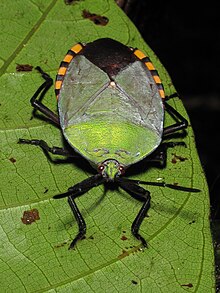Natalicolinae
| Tessaratomidae | |
|---|---|
 |
|
| Pycanum rubens, an adult from the Gunung Mulu National Park, Malaysia | |
| Scientific classification | |
| Kingdom: | Animalia |
| Phylum: | Euarthropoda |
| Class: | Insecta |
| Order: | Hemiptera |
| Suborder: | Heteroptera |
| Infraorder: | Pentatomomorpha |
| Superfamily: | Pentatomoidea |
| Family: |
Tessaratomidae Stål, 1864 |
| Type genus | |
|
Tessaratoma Lepeletier & Serville, 1825 |
|
| Subfamilies | |
|
See text |
|
See text
Tessaratomidae is a family of true bugs. It contains about 240 species of large bugs divided into 3 subfamilies and 56 genera.
Tessaratomids resemble large stink bugs (family Pentatomidae) and are sometimes quite colorful. Most tessaratomids are Old World, with only three species known from the Neotropics. Some members of Tessaratomidae exhibit maternal care of eggs and offspring. The defensive chemicals of certain species can cause significant damage if they come into contact with human skin; they may also cause temporary blindness.
All species are exclusively plant-eaters, some of major economic importance as agricultural pests. A few species are also consumed as human food in some countries.
Larger species of Tessaratomidae are known informally as giant shield bugs, giant stink bugs, or inflated stink bugs, but they generally do not have a collective common name and are referred to mostly as tessaratomids.
Tessaratomids are ovate to elongate-ovate bugs. They range in size from the smallest members of the tribe Sepinini at 6 to 7 mm (0.24 to 0.28 in), to the large Amissus atlas of tribe Tessaratomini at 43 to 45 mm (1.7 to 1.8 in). They are generally quite large and usually exceed 15 mm (0.59 in) in length.
The head of tessaratomids is generally small and triangular, with the antennae having 4 to 5 segments (though some of them, for example Siphnus, have relatively large heads). The scutellum (Latin for 'little shield', the hard extension of the thorax covering the abdomen in hemipterans) is triangular and does not cover the leathery middle section of the forewing but is often partially covered by the prothorax. The tarsi (the final segments of the legs) have 2 to 3 segments. They are most reliably distinguished from pentatomids by having six exposed abdominal spiracles instead of five.
...
Wikipedia
